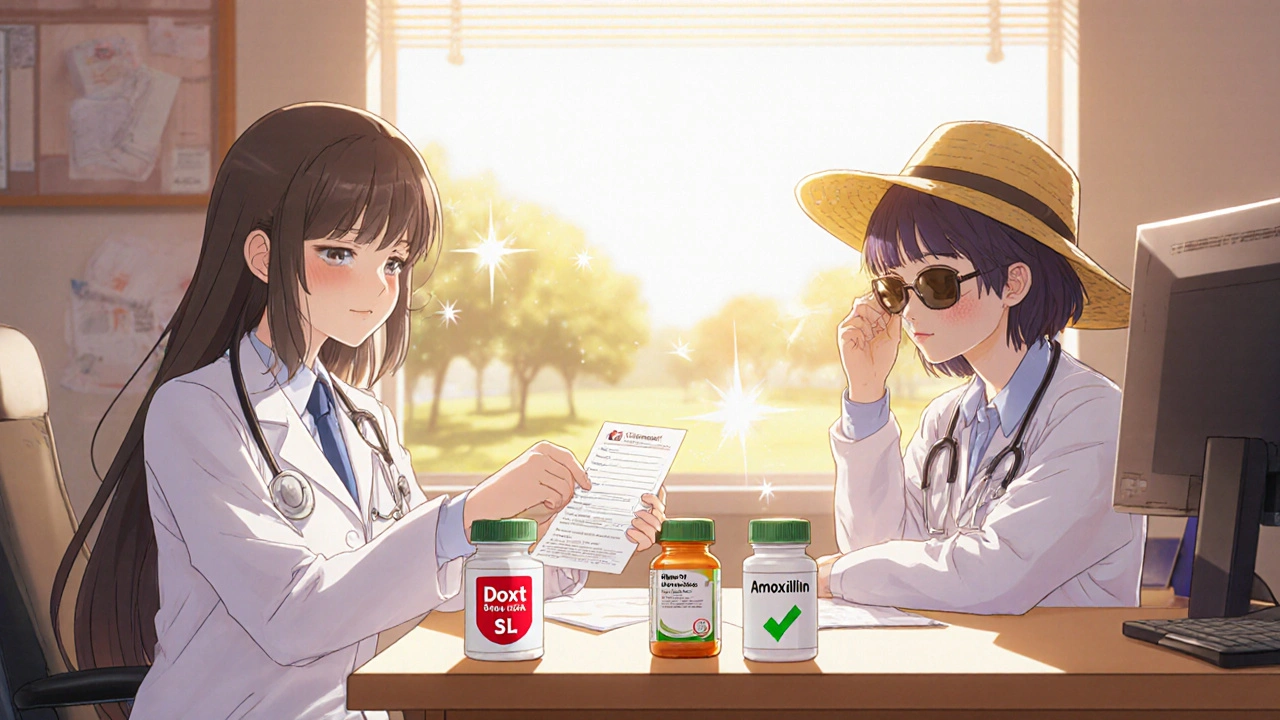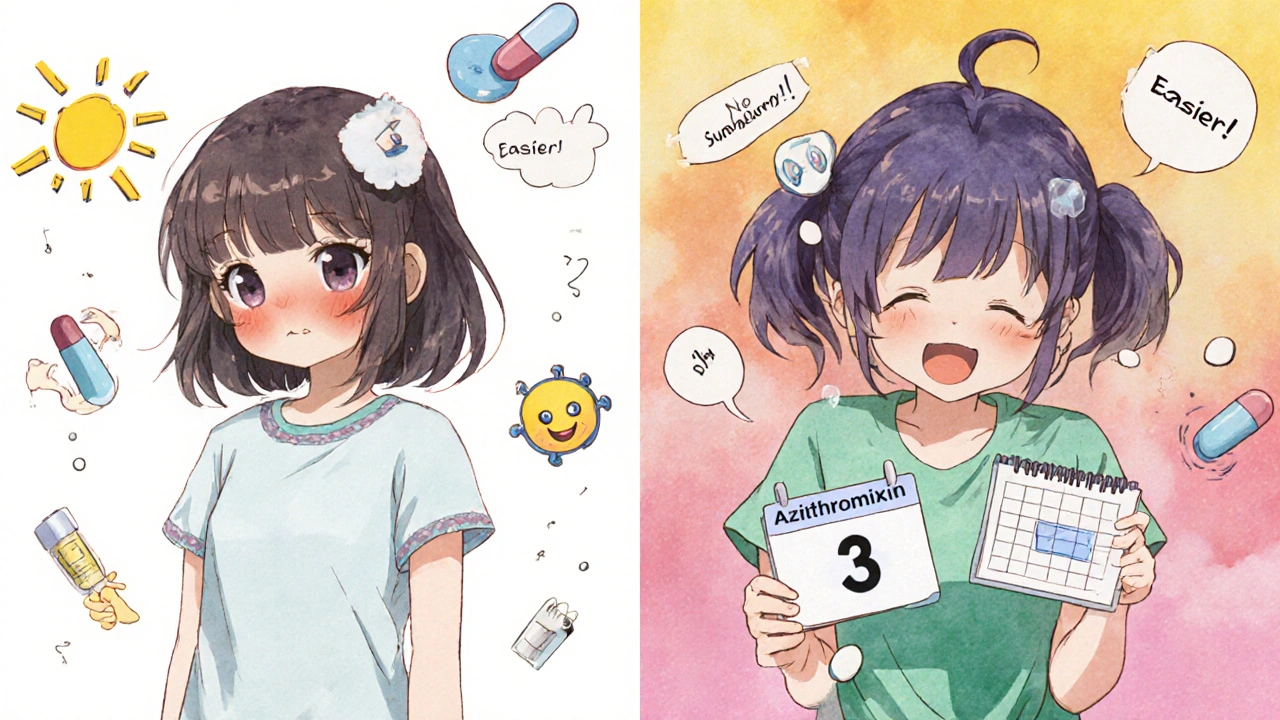Antibiotic Comparison Tool
Find the Right Antibiotic for You
This tool helps you compare Doxt-SL (doxycycline) with common alternatives based on your condition, side effects, and budget. Enter your situation below to get personalized recommendations.
When you're prescribed Doxt-SL, you're getting a brand of doxycycline - a broad-spectrum antibiotic used for everything from acne and Lyme disease to respiratory infections and tick-borne illnesses. But if you've ever wondered whether there's a better, cheaper, or gentler option, you're not alone. Many people switch because of side effects, cost, or because their doctor suggests an alternative. This guide breaks down how Doxt-SL stacks up against other antibiotics you might actually be prescribed instead.
What Doxt-SL Actually Does
Doxt-SL contains doxycycline hyclate, a tetracycline-class antibiotic. It works by stopping bacteria from making proteins they need to survive. That makes it effective against a wide range of infections, including chlamydia, urinary tract infections, pneumonia, and even some types of malaria prevention.
It’s usually taken once or twice a day, on an empty stomach, with a full glass of water. You can’t lie down for at least 30 minutes after taking it - otherwise, it can irritate your esophagus. That’s one reason people look for alternatives. Others stop because of nausea, sun sensitivity, or yeast infections.
Doxt-SL is not a magic bullet. It doesn’t work on viral infections like colds or flu. And if you’ve taken it before and it didn’t help, your doctor might consider something else.
Common Alternatives to Doxt-SL
Doctors choose antibiotics based on the infection type, your medical history, allergies, and even local resistance patterns. Here are the most common substitutes for doxycycline:
- Amoxicillin - A penicillin-based antibiotic. Often used for sinus infections, ear infections, and strep throat. It’s gentler on the stomach and doesn’t cause sun sensitivity like doxycycline.
- Azithromycin - A macrolide antibiotic. Popular for respiratory infections and chlamydia. Often given as a single dose or 3-day course, which makes it easier to stick with.
- Cephalexin - A first-generation cephalosporin. Used for skin infections, bone infections, and some urinary tract infections. Good for people allergic to penicillin in some cases.
- Minocycline - Another tetracycline, similar to doxycycline. Sometimes used for acne or Lyme disease. It’s more likely to cause dizziness or vertigo.
- Metronidazole - Not a direct replacement, but used for anaerobic infections like bacterial vaginosis or C. diff. Often paired with other antibiotics.
Each of these has different strengths. Amoxicillin is cheaper and safer for kids. Azithromycin is convenient. Cephalexin is less likely to disrupt your gut flora. Minocycline can be more effective for severe acne but comes with more neurological side effects.
Side-by-Side Comparison
Here’s how Doxt-SL compares to the top alternatives across key factors:
| Antibiotic | Typical Use | Dosing Frequency | Common Side Effects | Sun Sensitivity? | Cost (NZD, 30-day course) |
|---|---|---|---|---|---|
| Doxt-SL (Doxycycline) | Lyme disease, acne, respiratory, tick-borne infections | Once or twice daily | Nausea, diarrhea, yeast infections, upset stomach | Yes - high risk | $25-$40 |
| Amoxicillin | Ear, sinus, strep throat, UTIs | Two to three times daily | Diarrhea, rash, mild nausea | No | $15-$25 |
| Azithromycin | Chlamydia, bronchitis, pneumonia | Once daily (often 5-day or single dose) | Diarrhea, stomach cramps, headache | No | $30-$50 |
| Cephalexin | Skin, bone, urinary tract infections | Two to four times daily | Diarrhea, nausea, vaginal itching | No | $20-$35 |
| Minocycline | Severe acne, Lyme disease | Once or twice daily | Dizziness, vertigo, blue-gray skin discoloration | Yes - moderate risk | $35-$60 |
Notice the pattern? Doxt-SL is effective but comes with trade-offs. If you’re spending time outdoors, the sun sensitivity is a real problem. If you’re trying to avoid daily pills, azithromycin’s single-dose option wins. If cost matters, amoxicillin is often the most affordable.

When to Stick With Doxt-SL
Doxt-SL isn’t going away - and for good reason. It’s still the go-to for several conditions:
- Lyme disease - Doxycycline is the first-line treatment in early stages. Alternatives like amoxicillin work too, but doxycycline is preferred for its better penetration into tissues.
- Acne - Long-term low-dose doxycycline is standard. Azithromycin can be used, but it’s less effective for chronic cases.
- Tick-borne illnesses - Like Rocky Mountain spotted fever or ehrlichiosis. Doxycycline is the only recommended option.
- Malaria prevention - Only doxycycline and atovaquone-proguanil are used in high-risk areas. No other common antibiotic works here.
If your doctor prescribed Doxt-SL for one of these, switching might not be safe or effective. Don’t assume all antibiotics are interchangeable - they’re not.
When to Ask for Something Else
Consider asking for an alternative if:
- You get severe nausea or vomiting after taking it
- You’re planning a beach trip or outdoor activity and don’t want to risk sunburn
- You’ve had yeast infections before and want to avoid triggering another
- You’re on a tight budget and need the cheapest effective option
- You’re allergic to tetracyclines or have had a bad reaction before
Some people switch to azithromycin for chlamydia because it’s a single pill. Others switch to amoxicillin for sinus infections because it’s gentler. There’s no shame in asking - doctors expect it.
What You Should Never Do
Antibiotics aren’t candy. Don’t:
- Stop taking Doxt-SL just because you feel better - finish the full course, even if symptoms disappear
- Share your prescription with someone else - what works for you might be dangerous for them
- Use leftover antibiotics for a new infection - this fuels antibiotic resistance
- Take it with dairy, antacids, or iron supplements - they block absorption
Also, never buy antibiotics online without a prescription. Fake or expired meds are common, and they can make infections worse.

Real-World Examples
A 28-year-old in Wellington got Doxt-SL for a tick bite after hiking in the Tararua Ranges. She developed a bad sunburn on her shoulders after two days and couldn’t work outside. Her doctor switched her to amoxicillin - same effectiveness, no sun risk.
A 45-year-old man with recurring acne had been on Doxt-SL for 8 months. He got dizzy every morning. His dermatologist switched him to minocycline, which worked better for his skin - but he had to take it with food to avoid nausea.
A 62-year-old woman with pneumonia was prescribed azithromycin instead of doxycycline because she was on blood thinners. Doxycycline can interact with warfarin - azithromycin doesn’t.
These aren’t rare cases. They happen every day in clinics across New Zealand.
How to Talk to Your Doctor About Alternatives
You don’t need to sound like a medical expert to have this conversation. Try these phrases:
- “I’m having trouble with the side effects - is there another option?”
- “I’m planning to be outdoors a lot this month. Is there something that won’t make me sun-sensitive?”
- “This is a bit expensive for me. Is there a cheaper generic?”
- “I’ve taken doxycycline before and it didn’t work. What else might help?”
Doctors appreciate when patients ask smart questions. They’re not offended - they’re glad you’re paying attention.
Can I take doxycycline with food?
You should take doxycycline on an empty stomach, at least one hour before or two hours after eating. Food, especially dairy, calcium, or iron-rich meals, can block absorption. If stomach upset is a problem, take it with a light snack like toast - but avoid milk, yogurt, or antacids.
Is Doxt-SL better than generic doxycycline?
No. Doxt-SL is just a branded version of generic doxycycline hyclate. Both contain the same active ingredient, same dosage, and same effectiveness. The only difference is price - generic is usually 60-80% cheaper. In New Zealand, Pharmac lists generic doxycycline as a subsidized option, making it the smarter choice unless your doctor has a specific reason to prescribe the brand.
Can I use azithromycin instead of doxycycline for acne?
Azithromycin can be used for acne, especially if you can’t tolerate doxycycline. But it’s not as effective for long-term control. Doxycycline reduces inflammation in the skin better over time. Azithromycin is often used short-term or for patients with antibiotic resistance to tetracyclines.
Why does doxycycline make me sun-sensitive?
Doxycycline absorbs UV light and triggers a reaction in your skin cells, leading to severe sunburns even with minimal exposure. This effect can last for days after you stop taking it. Always use broad-spectrum SPF 50+, wear hats, and avoid direct sun. If you’re outdoors often, ask your doctor about alternatives like amoxicillin or cephalexin.
What happens if I miss a dose of Doxt-SL?
If you miss a dose, take it as soon as you remember - unless it’s almost time for the next one. Never double up. Missing doses can lead to antibiotic resistance. If you’re struggling to remember, set phone alarms or use a pill organizer. For chronic conditions like acne, some doctors prescribe a weekly dose to improve compliance.
Final Thoughts
Doxt-SL is a powerful tool - but it’s not the only one. The best antibiotic isn’t always the most famous one. It’s the one that works for you, fits your lifestyle, and doesn’t cause more problems than it solves. If you’re unhappy with your current treatment, talk to your doctor. There’s almost always another option that’s just as effective - and maybe even better.

Erika Puhan
November 6, 2025 AT 11:19Doxt-SL is just a rebranded generic with a 300% markup. The fact that doctors still prescribe it without mentioning cost is a symptom of pharmaceutical capture. Pharmac already subsidizes the generic-why are we enabling this rent-seeking behavior? It’s not just unethical, it’s statistically indefensible.
And let’s not pretend sun sensitivity is ‘inconvenient.’ It’s a documented phototoxic reaction with potential for long-term dermal damage. If your dermatologist prescribes this without a risk-benefit analysis, they’re not practicing medicine-they’re performing corporate logistics.
Also, Azithromycin for acne? That’s not ‘an option,’ it’s a last-resort stopgap. You’re just delaying resistance. We’ve seen this movie before with MRSA. The real issue is systemic overprescribing, not which tetracycline you’re on.
Minocycline’s vertigo? Yeah, that’s a known CNS effect. But at least it’s not turning your skin into a sunburn canvas. Priorities, people.
And yes, I’m aware this is a New Zealand post. But the global antibiotic industrial complex doesn’t care about borders. This is a public health failure dressed up as patient choice.
Edward Weaver
November 7, 2025 AT 08:45LMAO you people are overthinking this. Doxt-SL works. It’s what the military uses for Lyme in the field. If you can’t handle a little sun sensitivity, maybe don’t go outside. America’s got the best meds in the world-stop whining about $25. Get a job, buy sunscreen, and stop treating antibiotics like Starbucks.
Amoxicillin? That’s for kids with ear infections. Azithromycin? That’s for people who can’t read a prescription label. If you need a 5-day course just to get through a cold, you’re not sick-you’re lazy.
Generic? Yeah, it’s the same. But if you’re gonna take a pill, take the one that actually works. Don’t be a cheap bastard and risk treatment failure. I’ve seen guys get sepsis from ‘saving’ $10. Don’t be that guy.
Lexi Brinkley
November 7, 2025 AT 09:59Okay but like… sun sensitivity?? 😵💫 I got Doxt-SL last year and my arms looked like I’d been in a tanning bed for 12 hours 😭 I switched to azithromycin and it was a GAME CHANGER. No more burning, no more hiding from the sun 🌞🚫 and honestly? It worked just as well for my acne. Also, single dose for chlamydia?? YES PLEASE 🙌
PS: Generic doxycycline is literally the same. Why pay more?? 🤦♀️
Kelsey Veg
November 8, 2025 AT 18:28doxycycline is the worst. i took it for acne and got so nauseous i threw up every time. then i got yeast infection so bad i couldnt sit down. switched to azithromycin and boom. no more drama. why do docs keep pushing this? its like they dont even read the side effects. also its like 3x the price of generic. so dumb.
also dont take it with milk. i did that once and felt like i swallowed sand. lol
Alex Harrison
November 10, 2025 AT 05:18Really appreciate this breakdown. I was on Doxt-SL for Lyme after a tick bite and the sun sensitivity was brutal-I had to cancel a camping trip. Switched to amoxicillin and it worked just fine. Also, the generic is way cheaper and I didn’t notice any difference. Just wish more doctors would mention alternatives upfront instead of making you figure it out after three bad side effects.
And yes, never take it with dairy. Learned that the hard way. Set phone alarms for doses-life saver.
Jay Wallace
November 11, 2025 AT 06:54Let’s be clear: Doxt-SL is not a ‘brand.’ It’s a trademarked placebo wrapper. The active ingredient is doxycycline hyclate-identical to the $12 generic. The fact that this is even a discussion in 2025 is a national disgrace. Pharmaceutical lobbying has turned antibiotic prescribing into a carnival game.
And yet, people still believe ‘brand equals better.’ No. It equals profit. You’re not getting ‘premium care’-you’re being scammed. Shame on every prescriber who doesn’t lead with the generic.
Also: minocycline causes blue-gray skin discoloration? That’s not a side effect-that’s a life-altering cosmetic disaster. Who approved this? The FDA? Please.
Alyssa Fisher
November 11, 2025 AT 11:32It’s fascinating how we treat antibiotics like interchangeable tools, when they’re actually highly specific molecular keys. Doxycycline works because it binds to the 30S ribosomal subunit in a way that’s uniquely effective against intracellular pathogens like Borrelia.
Amoxicillin? It targets cell wall synthesis-great for extracellular bugs, useless for Lyme.
Azithromycin? It’s a macrolide, so it disrupts protein synthesis differently-good for chlamydia, subpar for deep tissue penetration.
So when someone says ‘just switch,’ they’re ignoring pharmacodynamics. The real question isn’t cost or convenience-it’s whether the pathogen’s molecular vulnerability matches the drug’s mechanism.
That’s why doxycycline remains gold standard for Lyme. Not because it’s branded. Because evolution didn’t design a better key.
Alyssa Salazar
November 11, 2025 AT 22:44Okay, but the sun sensitivity thing? Absolute nightmare. I was hiking in Colorado and got sunburned through my shirt. Like, literally. My dermatologist switched me to minocycline and I thought, ‘this’ll be better’-then I got dizzy every morning like I was on a rollercoaster. 😵💫
Ended up on low-dose azithromycin for acne. Not perfect, but manageable. And honestly? The fact that we have options is why I love modern medicine. But doctors need to stop treating this like a one-size-fits-all script. We’re not lab rats.
Also, generic doxycycline is literally the same. Stop paying extra. 🙏
Beth Banham
November 12, 2025 AT 08:18This was really helpful. I’ve been on Doxt-SL for months and didn’t realize the generic was identical. I’ll ask my doctor next time. Also, didn’t know about the dairy thing-always took it with yogurt. Oops.
Thanks for the real talk. I feel less alone now. 😊
Brierly Davis
November 13, 2025 AT 10:34Hey, just wanted to say-this post saved me. I was about to quit my antibiotic because of the nausea, but now I know it’s not me, it’s the drug. I’m going to ask for amoxicillin for my sinus infection. Also, setting alarms for doses? Genius. I’m using a pill box now too. Small changes, big difference.
You’re doing great. Keep sharing this stuff. 💪
Amber O'Sullivan
November 15, 2025 AT 09:07Doxt-SL is overpriced nonsense. Generic works. Sun sensitivity is real. Azithromycin for chlamydia is easier. Done. Why is this even a debate? Doctors need to stop being lazy. End of story.
Also stop taking it with milk. You're not a toddler
Jim Oliver
November 16, 2025 AT 23:55Wow. Just… wow. You people are so obsessed with ‘alternatives’ that you’ve forgotten antibiotics are not a buffet. Doxycycline is the gold standard for Lyme. Period. If you can’t handle the sun, don’t go outside. If you can’t handle the cost, don’t get sick. If you can’t handle the side effects, go home and cry into your kale smoothie.
And yes, the generic is the same. But if you’re too cheap to pay $25, maybe you shouldn’t be taking antibiotics at all. Your immune system will thank you. Or not. Either way, it’s your funeral.
William Priest
November 17, 2025 AT 15:54Doxt-SL? Please. That’s like calling aspirin ‘Aspirin-X Pro Max.’ The real issue here is that people don’t understand pharmacokinetics. Doxycycline’s half-life is 18 hours-so once daily dosing is pharmacologically optimal. Azithromycin? 68-hour half-life. That’s not ‘convenient,’ that’s a pharmacokinetic anomaly designed for compliance, not efficacy.
And minocycline? That’s a tetracycline derivative with higher CNS penetration-hence the vertigo. It’s not a ‘side effect,’ it’s a targeted bioavailability profile.
Amoxicillin? Penicillinase-sensitive. Useless against beta-lactamase producers. You’re trading efficacy for ‘gentleness.’ That’s not medicine. That’s appeasement.
Ryan Masuga
November 18, 2025 AT 01:51Thanks for writing this. I’ve been on doxycycline for acne and thought I was just unlucky with side effects. Turns out I just needed to take it on an empty stomach and avoid dairy. Also, switched to generic and saved $30. Didn’t even notice a difference.
Biggest takeaway? Don’t suffer in silence. Talk to your doctor. There’s almost always a better fit. You’re not being ‘hard to please’-you’re being smart.
Also, sunscreen. Always sunscreen. 🧴☀️